In the 1960s, you'd notice men's dress shirts evolving dramatically, reflecting a cultural revolution. Gone were the plain styles; instead, you'd find bold paisley and geometric patterns in vibrant colors like lime green. The Peacock Revolution popularized slim-fit designs and short sleeves, making shirts more expressive. Fabrics like cotton-polyester blends enhanced comfort, suitable for both formal and casual occasions. Notable brands like Arrow and Van Heusen shaped this era's fashion, catering to a desire for individuality. As you consider these stylish transformations, there's more intriguing history to uncover about how these trends emerged.
Evolution of Dress Shirt Styles

The 1960s marked a significant turning point in the evolution of men's dress shirt styles, as traditional designs gave way to more expressive and adventurous aesthetics. You'd notice that shirts began to reflect the cultural shifts of the decade, moving away from conservative looks to embrace bold colors and unique patterns. This transformation was largely influenced by the Peacock Revolution, where slim-fit shirts became incredibly popular, often featuring floral vintage prints and geometric designs that made a statement. Many of these designs were characterized by unique labels that indicated their authenticity and era, showcasing the craftsmanship of the time, which is a vital aspect of identifying vintage clothing.
Innovative fabrics like polyester blends and cotton allowed for vibrant color retention and easy care, enhancing both comfort and durability. As you explored your wardrobe, you'd find that French cuffs gained prominence, providing a stylish canvas for decorative cufflinks that elevated your overall look. Layering became essential, with shirts frequently tucked into high-waisted trousers or worn beneath tailored jackets and vests, offering a polished yet expressive aesthetic.
The Ivy League influence also played a significant role, pushing the boundaries of what men's dress shirts could be. This era redefined vintage fashion norms, allowing you to showcase individuality through your attire while still adhering to a refined style.
Iconic Fabrics and Patterns
Men's dress shirts of the 1960s showcased an exciting array of iconic fabrics and patterns that defined the fashion landscape of the decade. Cotton was a popular choice, providing comfort and durability in a variety of styles. Many shirts featured a blend of materials, ensuring they remained practical for everyday wear while still being stylish. The decade embraced bold patterns, with paisley, floral, and geometric designs becoming signature elements. These vibrant patterns reflected the cultural shifts of the time, as fashion began to break free from traditional constraints.
Bright colors like lime green, mustard yellow, and sky blue dominated the scene, contrasting sharply with the muted tones of previous decades. This explosion of color was not just a trend; it symbolized a new era of self-expression and individuality. Retro variations of stripes emerged as another favored choice, often seen in both casual and formal designs, adding a playful touch to men's dress shirts. Additionally, the introduction of white piping on knit shirts elevated their visual appeal, showcasing the meticulous attention to detail that characterized 1960s fashion. Together, these iconic fabrics and patterns created a dynamic and memorable sartorial landscape.
Notable Brands and Designers
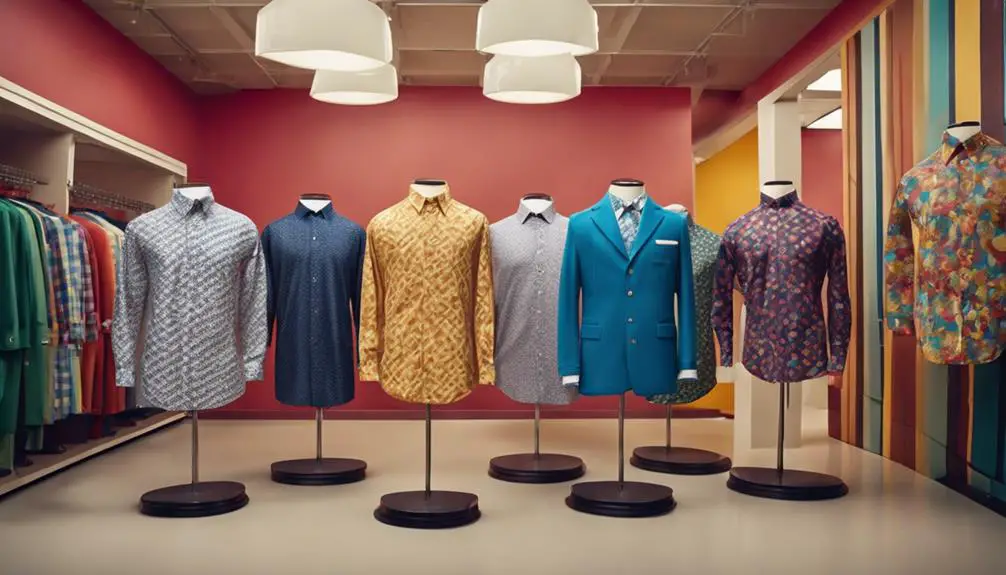
During the 1960s, a vibrant array of brands and designers emerged, each contributing to the evolving landscape of men's dress shirts. You'd find that these labels not only reflected the era's style but also catered to a variety of tastes and preferences.
Some notable names included:
- Arrow Shirts: Known for their quality craftsmanship and the classic Arrow RSVP tuxedo shirt, they became a staple for formal occasions.
- Van Heusen: Renowned for innovative designs, their cotton loop shirts showcased plaid and check patterns that appealed to both casual and formal wear markets.
- Gant: This brand emerged with stylish button-down shirts, capturing the essence of the decade's evolving fashion trends.
- Pendleton Wool Shirts: Offering vintage wool options, they maintained a classic American style that guaranteed durability and timeless appeal.
As you explore these brands, you'll see how their long sleeve shirts and unique designs set the standard for men's fashion in the 1960s. Collectors often sought after certain pieces, like the rare VTG 60s McGregor bandana shirt, illustrating the era's blend of practicality and flair.
Cultural Influences on Fashion
Expression flourished in the 1960s, as cultural movements and iconic figures reshaped men's fashion with unprecedented vigor. The civil rights movement and anti-war protests fueled a desire for individuality, allowing you to embrace bolder choices in your wardrobe. Slim-fit dress shirts became staples, often adorned with vibrant colors and patterns that reflected the era's spirit of rebellion and self-expression.
Musical icons like The Beatles and Bob Dylan not only transformed music but also influenced fashion trends, popularizing styles that broke away from traditional norms. The Peacock Revolution introduced a daring array of short sleeve shirts, featuring floral motifs and psychedelic designs, signaling a departure from conservative menswear.
Moreover, vintage-inspired pieces drew from international cultures, showcasing Hawaiian shirts that echoed the decade's fascination with travel and cultural exchange. The "Flower Power" movement encouraged you to wear clothing that celebrated peace and love, further embedding these ideals into fashion.
Television and media also played a significant role, swiftly circulating style trends that shaped consumer preferences. As you navigated fashion in the 1960s, each choice became a statement, reflecting the dynamic cultural landscape of the time.
Dress Shirts for Various Occasions
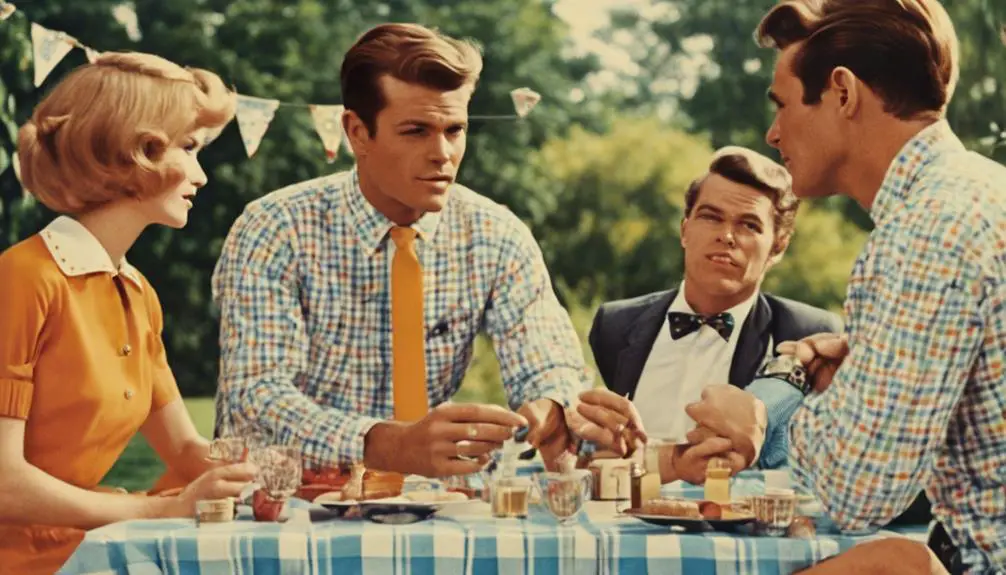
In the vibrant 1960s, dress shirts became essential wardrobe staples, expertly balancing formality and casual flair for various occasions. You'd find that the versatility of these shirts allowed you to dress appropriately for everything from business meetings to weekend outings. The decade's bold aesthetic influenced shirt styles, so whether you opted for a long sleeve button collar or a short sleeve button shirt, you were always in fashion.
Consider these key aspects when choosing a dress shirt for different events:
- Formal Events: Classic white or light-colored shirts paired with tailored suits and skinny ties.
- Casual Gatherings: Embrace vibrant patterns, like paisley or stripes, to express your personal style.
- Business Attire: Slim-fitting shirts in cotton-polyester blends for comfort and durability, often layered under blazers.
- Weekend Wear: Opt for short sleeve button shirts in bold colors or geometric designs for a relaxed look.
The 1960s cultivated a unique blend of vintage fashions that catered to both the refined and the expressive, making your choice of dress shirt a reflection of your personality and the occasion.
Tips for Vintage Shirt Collecting
When diving into vintage shirt collecting, it's crucial to hone in on the details that define authenticity and quality. Start by checking for original tags, which can indicate the shirt's brand and era. Look for brands like Arrow or Van Heusen, renowned for their quality in the 1960s. Understanding vintage tags can provide valuable insights into the shirt's provenance. Unique stitching patterns can also serve as a hallmark of genuine vintage dress shirts, adding to the piece's character.
Condition is key in your search. NOS (New Old Stock) items are often in pristine condition, but gently worn shirts can showcase the vintage appeal that collectors crave. Keep in mind the sizing differences; vintage sizes can differ greatly from modern standards, so always refer to size charts when evaluating potential purchases.
Don't forget to explore the vibrant patterns and colors that defined 1960s fashion trends. Paisley, bold stripes, and bright hues are particularly sought after. Finally, broaden your search to include online marketplaces and local vintage shops. Don't hesitate to negotiate prices, as many sellers are open to offers, providing you with a chance to snag that perfect shirt for your collection.
Frequently Asked Questions
What Shirts Did Men Wear in the 60s?
In the 60s, you'd see men sporting vibrant, patterned shirts featuring unique cuts. Button-down collars and tailored fits were popular, reflecting a shift toward individual expression and comfort in fashion during that dynamic decade.
Did Men Wear Bowling Shirts in the 60s?
Yes, you'd see men sporting bowling shirts in the 1960s, characterized by their vibrant colors and loose fit. These shirts became casual staples, reflecting the era's relaxed vibe and influencing broader fashion trends.
What Did Greasers Wear in the 1960s?
Greasers in the 1960s sported tight jeans or leather pants, classic T-shirts, and leather jackets. Their slicked-back hairstyles and accessories like bandanas and sunglasses completed a rugged, rebellious look that defined their subculture.
What Tops Were Worn in the 60s?
In the 60s, you'd see a variety of tops, from vibrant printed tees to relaxed hippie blouses. Each style reflected cultural shifts, with mod cuts and bold colors showcasing individuality and a break from tradition.
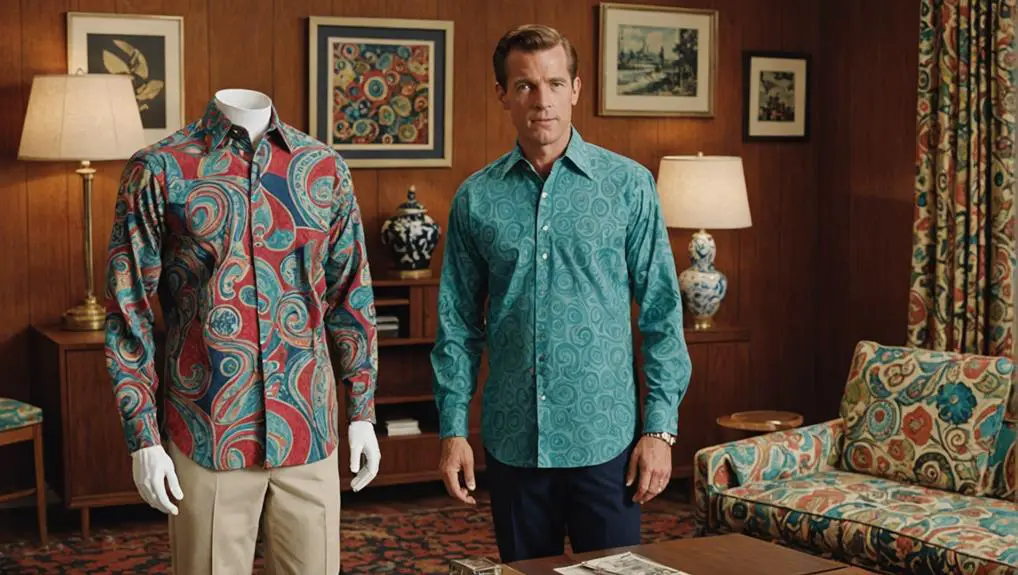

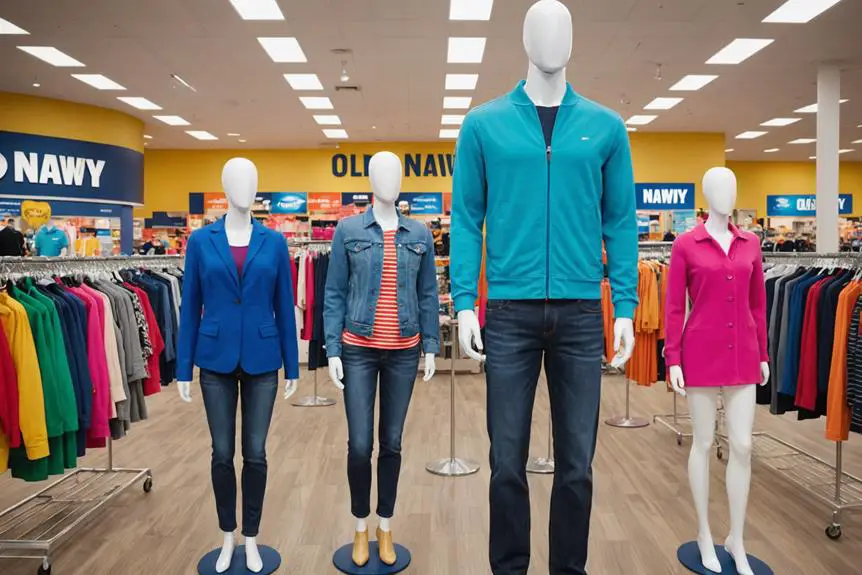
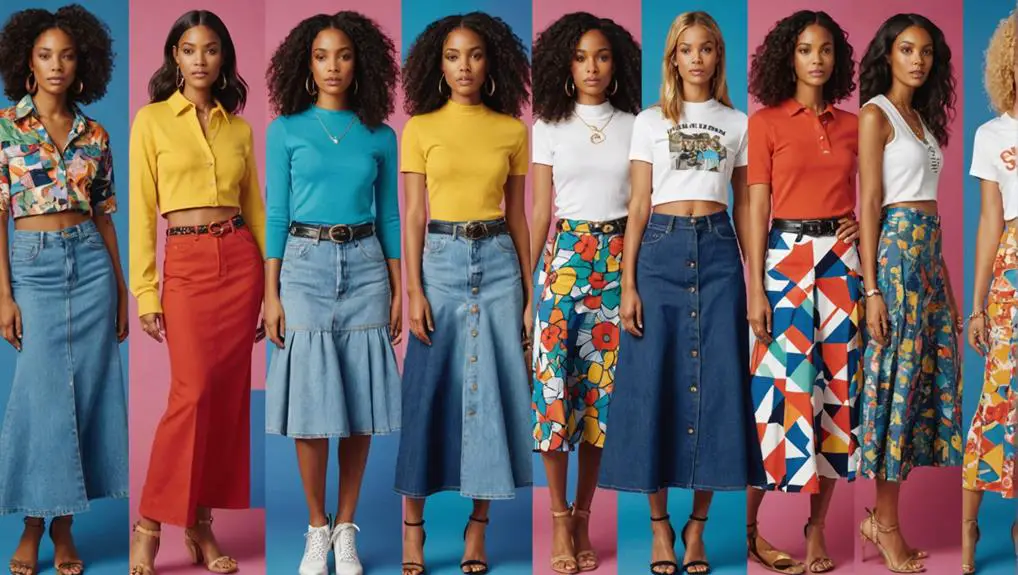
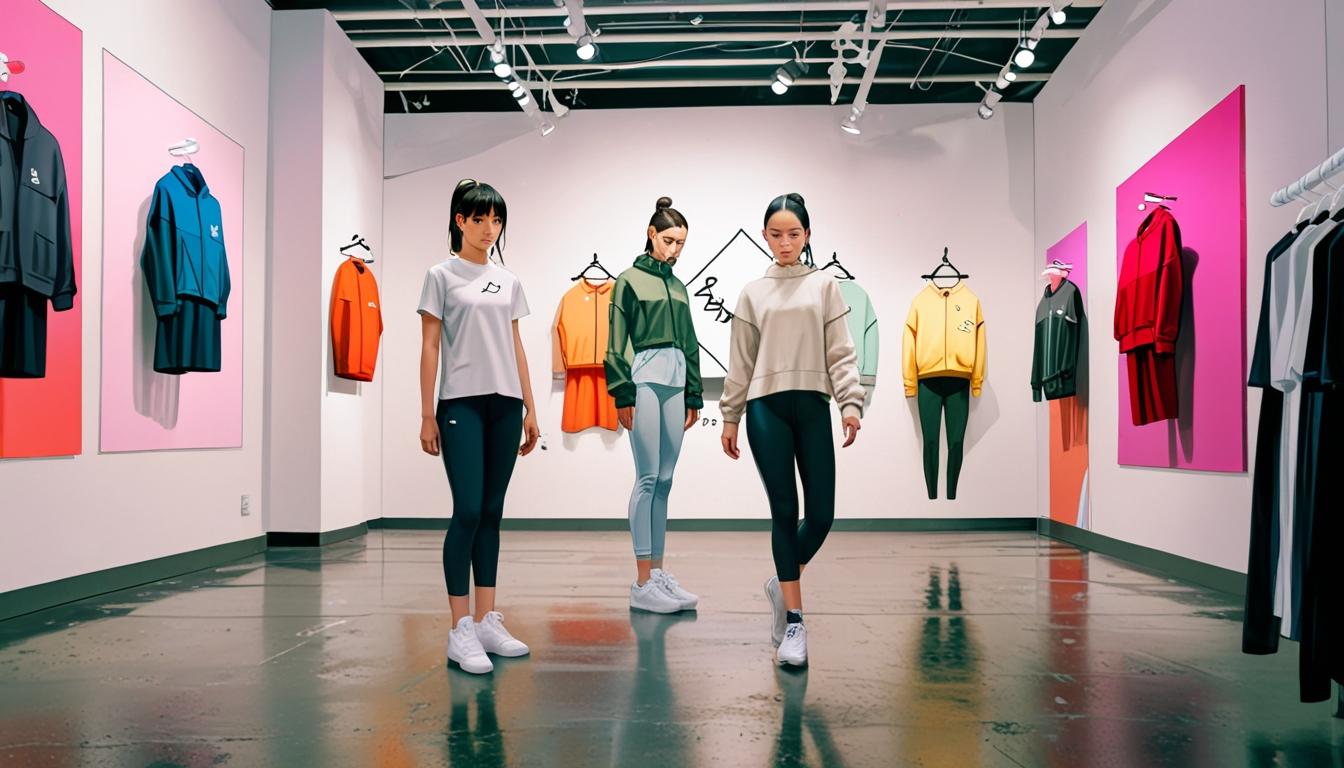
Thank you. Plenty of postings.
casino en ligne
You made your stand pretty clearly.!
casino en ligne
Amazing information. Cheers.
casino en ligne fiable
Many thanks! Loads of advice.
casino en ligne
You said it nicely..
casino en ligne
Nicely put, Appreciate it.
casino en ligne
Thanks! I appreciate it!
casino en ligne
Seriously loads of awesome data!
casino en ligne
Kudos, Quite a lot of information!
casino en ligne fiable
Lovely data, Appreciate it.
casino en ligne fiable